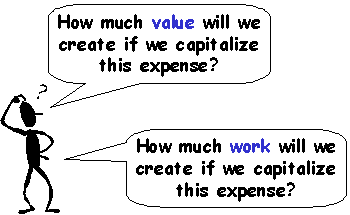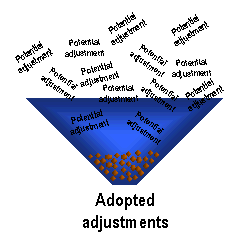Finalizing EP By Selecting Key Adjustments
GAAP has it all wrong. So what?
GAAP accounting may distort Baseline EP, and an alternative treatment may improve EP as a measure reflecting the economic changes in the business. But what counts is not what the adjustment does to the measure, but what the measure does to behavior.
We may reject the adjustment after considering actual benefits, in terms of important behavior, against the costs of implementing the adjustment in EP.
 Benefits
Benefits
Each adjustment should satisfy one of the four criteria mentioned in the "Adjustments" module, i.e., improve either the matching or objectivity of the measure, or insure that reports include only results for which managers should be held accountable and in which financing costs are segregated into the capital charges.
However, those changes in the measure are meaningful only to the extent that they are material enough to change behavior.
Costs
Adjustments introduce costs that tend to be shared by both information providers (i.e., finance staff generating reports), particularly in terms of data availability, and information users (i.e., operating management getting the reports) in terms of complexity. Often, these costs can be difficult to quantify, but they must nonetheless be weighed against the benefits.
 Filtering out unnecessary adjustments
Filtering out unnecessary adjustments
We ultimately want to strike the right balance between enouraging value creating behavior promoted with a focus on a custom EP measure, based on adjustments to Baseline EP, versus the extra time, energy and cost of creating or tracking those adjustments. Furthermore, there is no point in creating a "second set of books" if a couple key adjustments will get us most of the behavior that will drive value..
What follows are methods to qualify the benefits and costs of potentially relevant adjustments, individually and cumulatively, in moving from Baseline EP to a better, custom measure of EP.